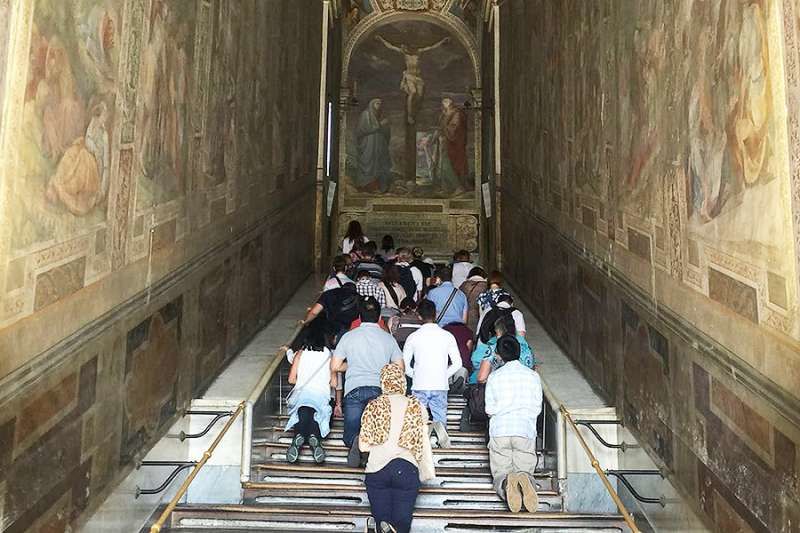The ‘Scala Santa,’ or ‘Holy Stairs,’ which are believed to be stairs trod by Jesus on the day of his trial and death, have closed for a year for restoration.
The restoration work appears to not be of the stairs themselves, but of the frescoes on the walls surrounding the stairs, which lead up to a once private papal chapel, the Church of St. Laurence.
During the closure, an image replicating the stairs covers the entrance and pilgrims who visit this year can ascend one of several other staircases just to the side of the original.
The Holy Stairs are held to be those which led to the praetorium of Pontius Pilate in Jerusalem, and which Jesus would have ascended on his way to the trial before his Crucifixion.
According to tradition, the stairs were brought to Rome by St. Helena in the 4th century. The mother of Emperor Constantine the Great, it is believed that she restored many holy sites in the Holy Land and discovered the True Cross, in addition to other relics.
The stairs, which are near the Archbasilica of St. John Lateran, were opened to the public approximately 400 years ago.
They are made of white marble, but are encased in wood for protection. In places, there are squares cut out of the wood where pilgrims can reach down to touch the marble. There are also glass cases protecting spots believed to have marks of the bloody footprint of Christ.
Pilgrims who visit the stairs must ascend them on their knees as a sign of piety and reverence, though they can choose how to pray, whether by saying a short prayer on each step or meditating on the Passion of Christ.
Those who cannot ascend on their knees may kneel on the first step and then walk up one of the other staircases to reach the top. The names of people who have visited the stairs since their opening can be seen carved with the date of their visit along these other staircases.
The faithful can also attain an indulgence, or remittance of temporal punishment due to sin, by climbing the stairs. To receive a plenary indulgence, they must ascend the entire staircase. Otherwise, a partial indulgence may be gained for every step on their knees while meditating on the Passion of Christ. The usual conditions for an indulgence must be met: making a sacramental confession, receiving the Eucharist, praying for the intentions of the Pope and being free of all attachment to sin.
Mountain Butorac, a Catholic tour guide living in Rome for four years, said that the Scala Santa is one of his favorite places to take pilgrims on his “The Catholic Traveler” tours in Rome. In 2017 alone, he took around 500 people, both Christians and non-Christians.
He told CNA that going up the stairs on one’s knees is a little painful, but thinking about what Jesus experienced during his Passion and Death, “makes it worth it.”
For him though, the best part of the Holy Stairs is seeing what it does for the people that he brings there. “That for me is what is so powerful, just to see how it affects people,” he said.
He has witnessed several re-conversions of people who had fallen away from the faith, he said. Sometimes people are moved to tears and filled with the sudden desire to go to the sacrament of confession, or to receive the Eucharist, after many years away.
“I encourage even people that aren’t Catholic to go up the stairs too,” he noted. “And a lot of times what happens is those are the people that have the most powerful experience.”
One Catholic man, Butorac said, had an experience on the stairs where he felt God calling him to give away the large sum of money he had saved for retirement. He has now spent the last few years donating his savings to the Church, “all because of the experience that he had on the stairs.”
Despite the closure, Butorac said he will continue to bring pilgrims, who can receive the same graces and indulgences by going up an alternate staircase during the restoration. “But you can bet I’ll be the first in when they reopen,” he said lightheartedly.

